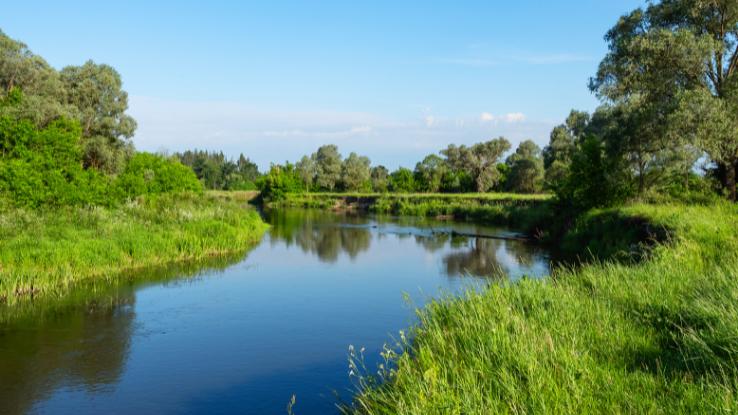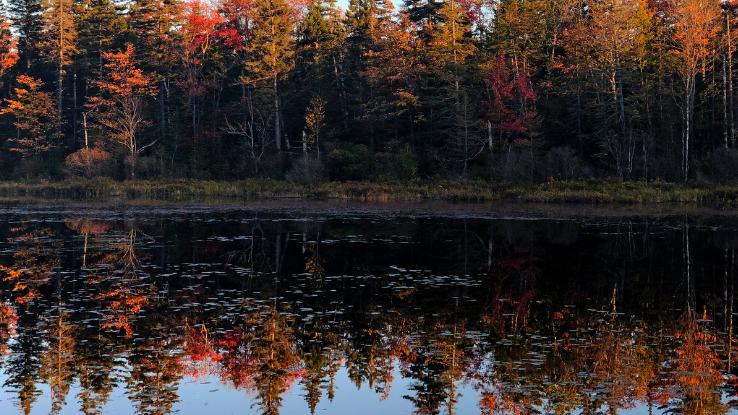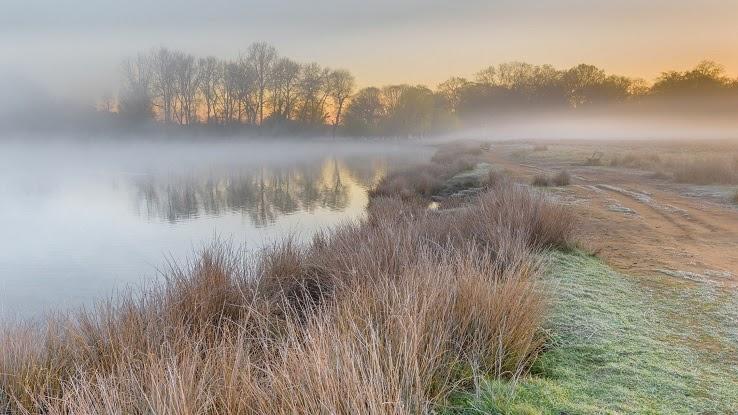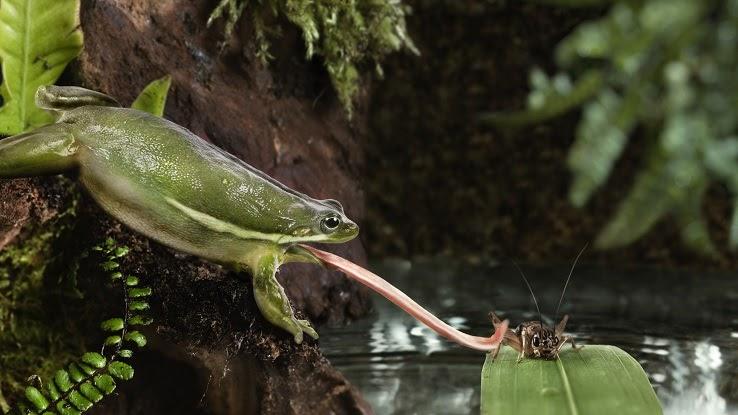How To Trap Muskrats In A Pond

While many think of manmade water features when they hear the word "pond," ponds are more than only decorative garden elements. In fact, at that place are plenty of naturally occurring ponds in a variety of different climates all over the world.
Moreover, ponds are a recognized ecosystem; their features distinguish them from other bodies of water, such equally lakes or streams, and, of course, pond ecosystems serve an essential role. And then, what is a pond ecosystem — and what types of organisms live in ponds? We're delving into these questions in more equally we plunge into the earth of ponds.
What Is a Pond Ecosystem?
A pond ecosystem involves the land that makes up the shoreline, the water that fills the pond, the life at the lesser of the pond, and the air higher up the pond. Within these ecosystems are animals that crawl, walk, swim, and fly.
By the Environmental Protection Bureau's (EPA) definition, a swimming is a body of water shallow enough for sunlight to reach its bottom. Usually, ponds are split up from other bodies of h2o, but they can be connected to oceans. Ponds connected to oceans are called lagoons. Large ponds are chosen lakes.
Since ponds are not often connected to larger bodies of h2o, the h2o independent in a pond does not flow through information technology. Large ponds can accept movement created past air current currents, but swimming water is always much more than stagnant than in a river or ocean.

Types of Pond Ecosystems
A pond can be classified equally any body of h2o that fills a pigsty in the ground. An interesting implication of that definition is that a pond can exist both naturally occurring or manmade. Both naturally occurring ponds and manmade ponds, such as those found in gardens and suburban neighborhoods, can back up ecosystems similar to natural ones when cared for properly.
Classifications of Pond Ecosystems
There are a multifariousness of types of natural ponds. Freshwater ponds are the nearly common. Brackish ponds are made from a mixture of saltwater and freshwater. Vernal ponds happen when in that location is a large hole in the ground. These ponds can announced during rainy seasons and disappear during dry out seasons. There are even some surreptitious ponds that are water-filled cavities that were created past hugger-mugger rock formations.
Swimming Ecosystem Factors
Pond ecosystems are made up of a network of living (biotic) and non-living (abiotic) factors that go on the environment working. Let's accept an in-depth look at both types of factors. First up? Abiotic factors.
Abiotic Factors
Sunlight is one abiotic factor that a pond ecosystem cannot survive without. Without sunlight, plants cannot abound and make energy for all of the animals that eat them. When a pond does not have plenty of admission to sunlight, there is a risk of the entire ecosystem collapsing due to a lack of food. The amount of sunlight a swimming receives also has a direct impact on its temperature. Some animals tin survive in colder h2o, whereas others need a warmer environment to thrive.
Water is perchance the most obvious abiotic factor within a pond ecosystem. The water provides a home for all of the plant and brute life in the ecosystem. This home is uniquely suited for fish gills to capture oxygen and for plants to grow. Animals in swimming ecosystems have fins, webbed feet, "waterproof" fur or feathers, and other body features that help them to motion efficiently through the water.
Beyond simply being a identify to exist, there are also many specific factors of water that make the pond ecosystem unique. For example, near ponds have low salt levels or salinity. In the average swimming, the level of salt is at our beneath 3,000 parts per 1000000. The salinity of ponds is specifically fabricated to support the plant and beast life native to the environment. Aquatic plants and animals are oft very sensitive to the amount of salt in the water. That's why you lot don't meet sharks and coral reefs at your local swimming.
Dissolved oxygen is one of the well-nigh precious resources in a swimming ecosystem. Oxygen is a byproduct of photosynthesis, the procedure that plants within a pond utilise to make energy. This same dissolved oxygen is necessary for other animals in the ecosystem to survive past breathing it in. If too many plants grow in an ecosystem, the plants tin can block out the sunlight. Without adequate sunlight, plants start to die, and their decomposition process removes dissolved oxygen from the water. Eventually, there are so many living and dead plants that sunlight is nearly completely blocked out and the water does not have enough oxygen to support life. Overgrowth of plants ofttimes happens when animal waste and fertilizer enters a pond as runoff.

Biotic Factors
Biotic components of a pond ecosystem are extremely varied depending on climate. Plants and phytoplankton are an important food source for the animals that live in a pond ecosystem. Algae and various forms of water lilies are common in many swimming ecosystems. Microscopic bacteria and protozoa assist to ensure that the soil within the ecosystem has enough nutrients to back up good for you establish life.
Ducks, geese, and other waterfowl are mutual in ponds. Reptiles like toads, frogs, snakes, and turtles frequent pond ecosystems. Larger mammals like raccoons and otters also live in ponds. Of class, 1 of the most plentiful types of creature life in any swimming is fish.
Organisms That Live in Ponds
Fish, bugs, birds, plants, and microscopic bacteria and plankton are just a few of the different organisms that are office of a pond ecosystem. Since many of the organisms in a swimming ecosystem cannot go out the pond, the organisms fulfill very specific needs for each other.

Nutrient Chain in Pond Ecosystem
The pond ecosystem food web has three levels. The pond ecosystem food chain starts with producers. These are plants and other phytoplankton that use sunlight to produce their own food, a source of plant free energy called ATP, through photosynthesis. Phytoplankton are tiny unicellular organisms. In other words, these tiny green organisms often have only i prison cell.
Adjacent, primary consumers become energy from producers by eating them. Zooplankton are the nearly mutual primary consumers in a pond ecosystem. These microscopic organisms are animals, and they tin have more than than 1 cell. Tadpoles, for example, are master consumers that commonly eat producers.
Secondary consumers make up the tertiary level of the pond food chain. These biotic organisms eat primary consumers, the animals that consume plants. Otters, frogs, snakes, and hawks are all examples of secondary consumers that are part of pond ecosystems.
Importance of Swimming Ecosystems
Ponds are important features of the environment because they are like a big water filter. As the abiotic factors in a pond use water and oxygen to grow and survive, pollutants and excess natural chemicals in the h2o are filtered out. When cleaner water is evaporated, better water re-enters the h2o cycle. The filtration that occurs in brackish ponds is even more valuable because these ponds stop polluted water from inbound the ocean.
Source: https://www.reference.com/science-technology/pond-ecosystem-238af6be85da0793?utm_content=params%3Ao%3D740005%26ad%3DdirN%26qo%3DserpIndex&ueid=bd7e8f2e-9d8b-416f-abb0-7dc4c96aab8c

0 Response to "How To Trap Muskrats In A Pond"
Post a Comment